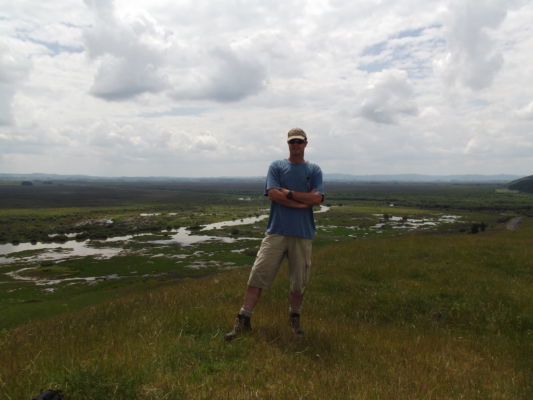Monitoring is an essential part of measuring the success of a predator control programme, but monitoring methods used in forests may not be directly applicable to wetlands. Tracking tunnels may not work, for example, where water levels fluctuate significantly.

It was an issue that faced Department of Conservation researchers Craig Gillies and Matthew Brady at Whangamarino wetland. They test and report on the validity of several predator monitoring techniques in a paper recently published in the New Zealand Journal of Zoology.
“Whangamarino wetland is about 62 km south of Auckland City and is a large lowland freshwater wetland comprising of marsh, swamp, fen, bog and the Whangamarino and Maramarua Rivers. It covers 6912 ha and is the second largest peat bog and swamp complex in the North Island. It is one of three nationally important sites managed under the Department of Conservation’s Arawai Kākāriki programme.”
The key objective of the Arawai Kākāriki programme is to reduce populations of introduced predatory mammals to levels that will allow the recovery of threatened wetland birds.
“Whangamarino is internationally recognised as a Ramsar site, in part because of the diverse populations of wetland birds living there, including marsh crakes, spotless crakes, North Island fernbirds and New Zealand dabchick. Up until recently Whangamarino also supported the largest breeding population of Australasian bittern in New Zealand, but these birds are now in serious decline at the site.”
(The Convention on Wetlands, called the Ramsar Convention, is an intergovernmental treaty that provides the framework for national action and international cooperation for the conservation and wise use of wetlands and their resources. There are 2,341 Ramsar wetlands around the world.)

The wetland also hosts a fairly diverse range of introduced mammal predators.
“Feral cats, ferrets, stoats, weasels, ship rats and Norway rats are all present in Whangamarino and collectively pose a significant threat to the wetland birds living there. However, existing monitoring techniques designed for measuring small pest mammal abundances in other environments may not be appropriate for the Whangamarino wetland. To understand the effectiveness of any pest control work, conservation managers need simple, cost-effective ways of measuring pest abundances. Unfortunately, though, tracking tunnels do not function in the Whangamarino wetland where water levels fluctuate considerably.”
Camera traps are one alternative monitoring option.
“Camera traps can be used to detect multiple species in a single survey; they are increasingly being used as a tool for monitoring wildlife and do not require specialist skills to operate. Camera traps could be used for monitoring feral cats and mustelids in Whangamarino, provided they can be deployed in such a way as to prevent them being submerged during flooding events.”
WaxTags are another monitoring tool that is fairly resistant to water damage.
“PCR WaxTags used for monitoring possums often also detect rodents and are unlikely to be damaged if they become submerged. However, before camera traps and PCR WaxTags can be used to monitor predatory mammals more widely in the Whangamarino wetland or other environments, they need to be validated by calibration against proven or accepted monitoring methods. The aim of this article is to report on trials we did to test simple camera trap indices of feral cat and ferret relative abundances and PCR WaxTag indices of rodent abundances, by comparing them to live-trap indices of pest abundances in the Whangamarino wetland.”

The research was carried out between 2010 and 2014 and involved humane live capture, tagging and release/recapture of predators present in the wetland.
“We caught and ear-tagged 44 individual (26 male and 18 female) feral cats, 112 individual (63 male and 49 female) ferrets, 79 individual (44 male and 35 female) ship rats and 50 individual (33 male, 16 female and one sex unknown) Norway rats in the live-trapping sessions. We caught and ear-hole punch marked 537 individual (297 male and 240 female) mice. We also caught and ear-tagged 21 weasels (16 male and five female) and one male stoat in the live-trapping sessions.”
Hedgehogs, possums, swamp harriers and blackbirds were also occasionally caught in live-traps and possums, rodents, hedgehogs, blackbirds, yellowhammers and other introduced birds were detected on camera traps on occasion. Interestingly, swamp harriers were detected in every survey and more frequently than any other animal, including feral cats and mustelids.
“We found that there were strong positive correlations between the camera trap indices and the associated live-trap indices of ferret abundances. There were modest, but significant positive correlations between camera trap indices and the associated live-trap indices of feral cat abundances. We also found that both 3-night and 7-night PCR WaxTag bite mark indices of rat or mouse abundances correlated strongly and positively with associated live-trap indices. We concluded that camera traps can be used to monitor ferret and feral cat abundances and PCR WaxTags can be used to monitor rodent abundances in the Whangamarino wetland and other environments.”
So if your predator control area is a tidal wetland and you need to monitor the success of your trapping and baiting efforts, WaxTags and camera traps are likely to work better for you than the usual tracking tunnel monitoring methods of drier habitats and these methods correlate well with live-trap indices of abundance.
The full research report is published in the New Zealand Journal of Zoology. Only the abstract is freely available online, but non-subscribers may be able to access the journal through their public library.
Trialling monitoring methods for feral cats, ferrets and rodents in the Whangamarino wetland (2018)

